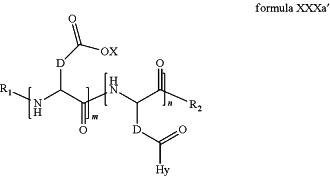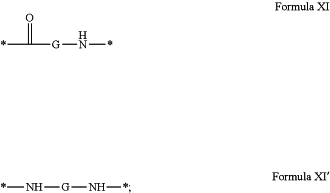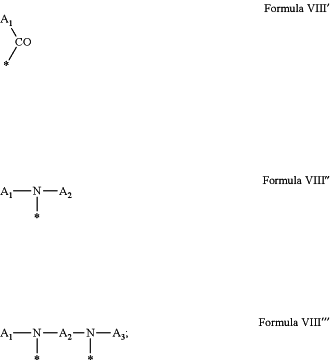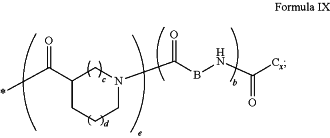| CPC A61K 47/34 (2013.01) [A61K 9/0019 (2013.01); A61K 9/2045 (2013.01); A61K 9/5084 (2013.01); A61K 38/28 (2013.01); A61K 47/42 (2013.01); A61K 47/62 (2017.08); A61P 3/08 (2018.01); C07K 14/62 (2013.01); C08G 69/10 (2013.01)] | 24 Claims |
|
1. A composition in the form of an aqueous injectable solution whose pH is comprised from 6.0 to 8.0, comprising at least:
a basal insulin whose isoelectric point pI is comprised from 5.8 to 8.5; and
a co-polyamino acid bearing carboxylate charges and hydrophobic radicals -Hy, said co-polyamino acid bearing carboxylate charges and hydrophobic radicals -Hy having units selected from the group consisting of glutamic units, aspartic units, and units according to formula XXXa′:
 wherein the hydrophobic radicals -Hy are according to formula X below:
 in which
GpR is chosen from the radicals according to formulas VII, VII′ or VII″:
 GpG and GpH are identical or different and each is chosen from the radicals according to formulas XI or XI′:
 GpA is chosen from the radicals according to formula VIII:
 in which A′ is chosen from the radicals according to formula VIII′, VIII″ or VIII′″:
 GpL is chosen from the radicals according to formula XII:
 GpC is a radical according to formula IX:
 the * indicates the attachment sites of the different groups bonded by an amide function;
a is an integer equal to 0 or to 1 and a′=1 if a=0 and a′=1, 2 or 3 if a=1;
a′ is an integer equal to 1, to 2, or to 3;
b is an integer equal to 0 or to 1;
c is an integer equal to 0 or to 1, and if c is equal to 0, then d is equal to 1 or to 2;
d is an integer equal to 0, to 1, or to 2;
e is an integer equal to 0 or to 1;
g is an integer equal to 0, to 1, to 2, to 3, to 4, to 5 or to 6;
h is an integer equal to 0, to 1, to 2, to 3, to 4, to 5 or to 6;
l is an integer equal to 0 or 1 and l′=1 if l=0, and l′=2 if 1=1;
r is an integer equal to 0, to 1, or to 2, and
s′ is an integer equal to 0 or 1, and
if e is different from 0, then at least one of g, h or l is different from 0; and
if a=0, then 1=0;
A, A1, A2 and A3, identical or different, are linear or branched alkyl radicals comprising 1 to 8 carbon atoms, optionally substituted by a radical derived from a saturated, unsaturated or aromatic ring;
B is a linear or branched alkyl radical comprising 1 to 9 carbon atoms, optionally comprising an aromatic nucleus, or an unsubstituted ether or polyether radical comprising from 4 to 14 carbon atoms and from 1 to 5 oxygen atoms;
Cx is a linear or branched monovalent alkyl radical, optionally comprising a cyclic part, in which x indicates the number of carbon atoms and:
when the hydrophobic radical -Hy carries 1-GpC, then 9≤x≤25,
when the hydrophobic radical -Hy carries 2-GpC, then 9≤x≤15,
when the hydrophobic radical -Hy carries 3-GpC, then 7≤x≤13,
when the hydrophobic radical -Hy carries 4-GpC, then 7≤x≤11,
when the hydrophobic radical -Hy carries at least 5-GpC, then 6≤x≤11;
G is a linear or branched alkyl radical of 1 to 8 carbon atoms, with said alkyl radical bearing one or more free carboxylic acid functions;
R is a radical chosen from the group consisting of a divalent alkyl radical, linear or branched, comprising 1 to 12 carbon atoms, a divalent alkyl radical, linear or branched, comprising 1 to 12 carbon atoms bearing at least one —CONH2 functions, and a unsubstituted ether or polyether radical comprising from 4 to 14 carbon atoms and 1 to 5 oxygen atoms;
the hydrophobic radical(s) -Hy according to formula X being bonded to the co-polyamino acid:
via a covalent bond between a carbonyl of the hydrophobic radical -Hy and a nitrogen atom borne by the co-polyamino acid, thus forming an amide function derived from the reaction of an amine function borne by the co-polyamino acid and an acid function borne by the precursor -Hy′ of the hydrophobic radical -Hy, or
via a covalent bond between a nitrogen atom of the hydrophobic radical -Hy and a carbonyl borne by the co-polyamino acid, thus forming an amide function derived from the reaction of an amine function of the precursor -Hy′ of the hydrophobic -Hy radical and an acid function borne by the co-polyamino acid;
the ratio M between the number of hydrophobic radicals and the number of glutamic and aspartic units being from 0<M≤0.5;
when several hydrophobic radicals are borne by a co-polyamino acid, then they are identical or different;
the degree of polymerization DP in glutamic or aspartic units of the co-polyamino acid is comprised from 5 to 250;
free carboxylic acid functions being in the form of an alkali metal salt chosen from the group consisting of Na+ and K+;
D represents, independently, either a —CH2— group (aspartic unit) or a —CH2—CH2— group (glutamic unit),
R1 is a hydrophobic radical -Hy or a radical chosen from the group consisting of an H, a linear acyl group comprising from 2 to 10 carbon atoms, a branched acyl group comprising from 4 to 10 carbon atoms, a benzyl, a terminal amino acid unit and a pyroglutamate,
R2 is a hydrophobic radical -Hy or a —NR′R″ radical, R′ and R″, either identical or different, being chosen from the group consisting of H, the linear or branched or cyclic alkyls comprising from 2 to 10 carbon atoms and benzyl, and said R′ and R″ alkyls may form together one or more saturated, unsaturated and/or aromatic cycle(s), and/or may comprise heteroatoms, chosen from the group consisting of O, N and S,
X represents a cationic entity chosen from the group consisting of Na+ and K+, and
n+m represents the degree of polymerization DP of the co-polyamino acid, namely, the average number of monomeric units per co-polyamino acid chain and 5≤n+m≤250.
|